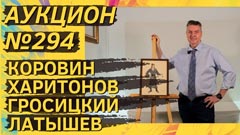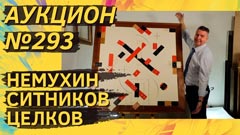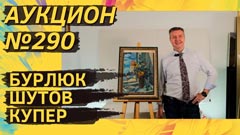
RUSSIAN ABROAD
LANSKOY André (1902–1976) Coming from outside. 1966. Oil on canvas. 73 × 99.5
André Lanskoy is the “count of abstractionism”, the founder of the direction of lyrical abstraction, one of the innovators of European abstract expressionism. He is indeed an aristocrat, a count by birth. He was born in St. Petersburg. His first lessons in painting were given to him by Alexandra Exter, the “Amazon of the Russian avant-garde”. In 1920, Lanskoy, together with the remnants of the White Guard, sailed to Constantinople, and from there he moved to Paris. He settled in the “Hive” in Montparnasse and quickly joined the ranks of French artistic bohemia. In Paris, Lanskoy continued his studies in the studio of Sudeikin, one of the founders of the Blue Rose, whose works the count had admired back in Russia. Unsurprisingly, Lanskoy was quite a figurative painter for the first ten or fifteen years. Only closer to the 1940s, under the influence of the ideas of Wassily Kandinsky and Paul Klee, abstraction captures the artist. Soon André Lanskoy becomes a prominent figure of the new direction, and it is the lyrical abstract expressionism that is considered the most valuable period in his work. Lanskoy's paintings are interesting because they are not formal geometric constructions. Unlike the works of many abstractionists, it is often possible to discern a figurative basis in them. It is especially valuable and interesting when we are faced not just with a “composition”, but with a preserved hint from the artist in the form of a “figurative” title. In our case, this is exactly the case. On the back the artist wrote: “Coming from outside”.
André Lanskoy as an artist was formed in France. Europeans, of course, consider him a French artist. And we consider him an artist of the Russian diaspora. After perestroika and the opening of the borders, Russian collectors began to acquire Lanskoy's paintings as well. In particular, they were brought to Russia by Parisian galleries as part of the Salon “The Best Galleries of the World in Moscow”, which was held in the early 2000s by the famous dealer Yves Bouvier. But even without Russian buyers, the artist formed a rich history of auction sales. There are almost 1700 paintings in the auction database. Interestingly, the price record was set quite recently. In 2019, a two-meter abstraction by Lanskoy was sold at Christie's for $320,000 — three times the estimate.
The painting presented, “Coming from outside”, belongs to the most valuable independent abstract period. It is signed, with the author's title preserved and a convincing provenance. In 2003, the painting was acquired in the Parisian gallery “Minotaur”, one of the main galleries for Lanskoy's work. And in 2006, André Schoeller — a leading French expert and compiler of Lanskoy's catalogue-raisonné — issued a written confirmation of authenticity for this painting.
1960s UNOFFICIAL ART
RABIN Oscar Yakovlevich (1928–2018) Railway. Lianozovo. 1961. Oil on canvas. 70 × 50
Atmospheric, subtle, moody work. And look at the year — 1961! Here it's useful to remember the context. What was that time? Everyone will remember that the Soviet cosmonaut is in space, the country is booming in industry, the USSR is on the rise. The Khrushchev Thaw is here, and the country is opening up to the world for the first time: the breakthrough Youth and Student Festival of 1957 thundered away, and in 1959 the American National Exhibition was held in Moscow. It would seem that live and be happy.
And what is 1961 for Rabin? “Moskovsky Komsomolets” has just written a pamphlet about the artist entitled “The Priests of Garbage No. 8”, which calls Rabin's art “a vile smut of the worst kind of abstractionist character”. Today you could shrug your shoulders: anything that is not an obituary is an advertisement. But in those days, a scandal in the national press threatened with dismissal from work, a "wolf's ticket" and further prosecution for parasitism. Why all of a sudden? They can't forgive Rabin for his gloomy portrayal of reality. But the artist does not have to go far for inspiration. In 1961, he and his family live in Lianozovo in the barracks of the recently closed women's camp. The bunk beds were removed. And in the rest — everything is like in the Gulag: floors through which grass grows, mold and devastation. For Rabin, however, even such conditions were an opportunity to work and meet like-minded people. In 1960, Lianozovo becomes part of Moscow, not the region. And this means that foreigners who were forbidden to leave the capital can come to Rabin. And so from the beginning of the 1960s, every Sunday is declared an open day at Rabin's barracks. Friends-artists, first buyers, foreigners, correspondents-diplomats come from the capital. The “Lianozovo school” is born. Communication, exchange of ideas, exhibitions and first sales take place. Around that time, with the mediation of Victor Louis, Rabin’s paintings begin to be bought by the London gallery owner Eric Estorick, who will play an important role in the world fame of the artist. But everything has its price — Rabin gets “on the pencil”, and the first provocations from the special services begin.
The “railway” depicted in the picture, is probably a memory of the station “Dolgoprudnaya”, where he worked in the 1950s as a loader, and then as a foreman of a brigade of “convicts” who were engaged in the construction of the Northern Waterworks. Rabin's paintings of this time have room for both gloominess and romance. So it is here. The atmosphere is overcast, but on the horizon, life is boiling, construction cranes are creaking and the future is being built. The tunnel in the foreground is also a metaphor. It is a symbol of hope. After all, only corridors end with a wall, but tunnels lead to light.
YAKOVLEV Vladimir Igorevich (1934–1998) Two flowers on a red background. 1974. Gouache on paper. 51 × 36
Just ten years ago there was the impression that Yakovlev flowers were plentiful, that there was no great difficulty in buying them, that there was no hurry, and that the price of $3,000 for a sturdy gouache seemed “biting”. Today, gouaches of a comparable class regularly hit the $15,000 mark, and it is very difficult to find a good piece. Time puts everything in its place.
The number of admirers of Yakovlev's work is not decreasing, on the contrary, it is growing. Exhibitions are regularly held, private collections develop. And the value of his work is constantly being revised upwards. Collectors, as well as 40–50 years ago, are captivated by the touching, sincerity and subtle philosophy of the artist's works. Yakovlev wrote not still lifes, but portraits of flowers. For him they were animate beings, symbols of the fragility of all that is beautiful in this life. “Two flowers on a red background” was painted in 1974, during the creative prime of the artist. The authenticity is confirmed by the expert opinion of Valery Silaev.
ZVEREV Anatoly Timofeevich (1931–1986) Laughing (Self-portrait?) 1957. Paper, ink, brush, watercolor. 58 × 39
Valery Silaev, an expert on the work of Anatoly Zverev, aptly noted the similarity of this work to a self-portrait. In most photographs of the late Zverev we see a stout, bearded and groggy man. That is how we are used to imagine him. But if you find a picture of a young Zverev (in 1957 the artist was 26 years old), you'll see a slender guy, without a beard, with a wide, radiant smile and a sly squint. Open the book “Anatoly Zverev in Memoirs of Contemporaries” and compare it with the picture “Laughing” — one face!
The end of the 1950s belongs to a particularly valuable period in the work of Zverev. The artist worked in an uninhibited expressive manner, experimented boldly, worked with pleasure. At this time he was patronized by the legendary collector George Costakis, who collected a large corpus of the artist's works. The drawing “Laughing” also comes from the collection of Costakis. The authenticity of the work is confirmed by the expert opinion of Valery Silaev.
VECHTOMOV Nikolay Evgenievich (1923–2007) Night reflections. 1986. Oil on canvas. 70 × 100
“Night reflections” is a large-format meter painting from 1986. For Vechtomov, this is an unusual color scheme, between red and yellow. The painting needs good lighting, and then the sun flashes and casts shadows on the fantastic biomorphic structures.
- Log in to post comments










